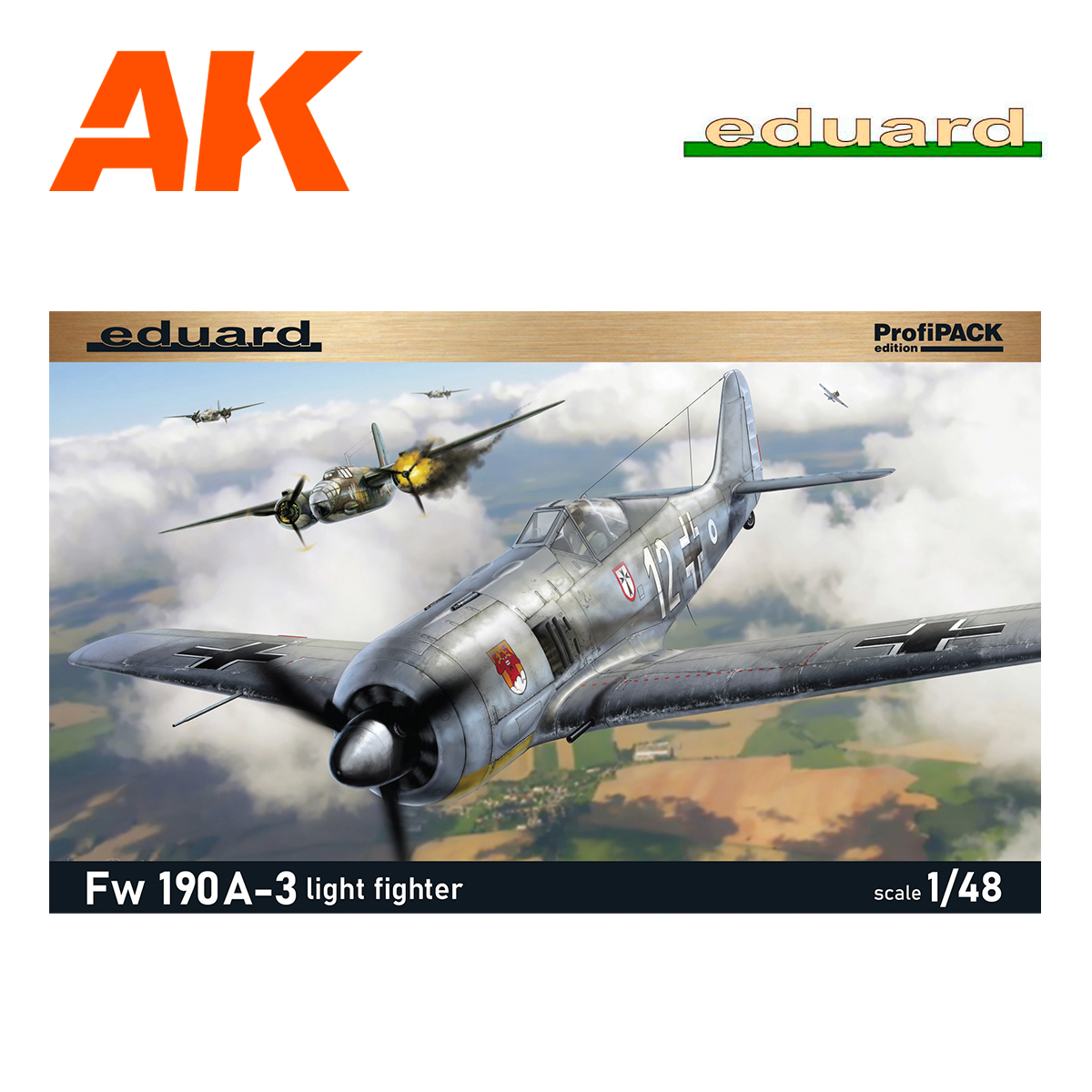Kit del avión de combate alemán de la Segunda Guerra Mundial Fw 190A-3. El kit ofrece A-3s armados con dos cañones en las alas.
– Piezas de plástico: Eduard
– Nº de opciones de calcas: 5
– calcomanías: Eduard
– Piezas de PE: sí, prepintadas
– máscara de pintura: sí
El Focke-Wulf Fw-190 es un avión de combate alemán, monomotor, totalmente metálico y con cabina cubierta con diseño de ala baja de la Segunda Guerra Mundial. Los pilotos consideraban que el Fw-190 era un avión mejor que el Messerschmitt Bf-109. El Luftfahrtministerium encargó un ala baja autoportante con un revestimiento de Fw-190 en funcionamiento, que se montó en el otoño de 1937. Kurt Tank presentó dos propuestas de propulsión: la primera con un motor Daimler-Benz DB 601 refrigerado por líquido, y la segunda con el nuevo motor radial BMW 139. Se eligió este último, y los trabajos iniciados en la primavera de 1938 fueron dirigidos por Obering R. Blaser. El primer prototipo del Fw-190V1 estuvo listo en mayo de 1939, y fue volado en Bremen el 1 de junio de 1939 por el capitán Hans Sander. El segundo prototipo, el FW-190V2, armado con dos ametralladoras MG131 y dos MG17, todas ellas del calibre 7,92 mm, voló en octubre de 1939. Para reducir la resistencia aerodinámica, ambos fueron equipados con una entrada de aire en túnel en la tapa de la hélice, pero los problemas de sobrecalentamiento del motor hicieron que se volviera al probado diseño de escudo NACA. Antes de que comenzaran definitivamente las pruebas de estos prototipos, ya se había tomado la decisión de sustituir el motor BMW 139 por un BMW 810 más potente, pero más largo y pesado. Esto requirió muchos cambios, reforzando la estructura y desplazando la cabina hacia atrás, lo que posteriormente se convirtió en una fuente de problemas con el centro de gravedad. La ventaja era la eliminación de los problemas de permeabilidad de los gases de escape y el sobrecalentamiento del interior de la cabina debido a su proximidad directa al motor BMW 139. Los prototipos tercero y cuarto fueron abandonados, y el Fw-190V5 con el nuevo motor se completó a principios de 1940. Más tarde, recibió alas con una envergadura ampliada en un metro (desde los 9,5 m originales), lo que lo hacía 10 km/h más lento, pero aumentaba la velocidad de ascenso y mejoraba la maniobrabilidad. Fue marcado como Fw-190V5g, y la variante con el ala más corta fue Fw-190V5k. Los primeros siete aparatos de la serie informativa Fw-190A-0 tenían un ala corta, el resto – una más larga. La primera unidad operativa equipada con el Fw-190 – 6./JG 26 estacionado en Le Bourget, declaró su disponibilidad operativa en agosto de 1941 y desde el primer encuentro del nuevo caza con el Supermarine Spitfire británico, su ventaja sobre ellos se hizo evidente. Durante la guerra, se crearon una docena de versiones de este gran avión. Las máquinas de la versión “A”, junto con una docena de modernizaciones, sirvieron como aviones de combate. Las versiones “B” y “C” eran sólo prototipos de cazas de gran altura destinados a combatir a los bombarderos estratégicos, pero no entraron en la producción en serie. La variante “D”, como la única de los Fw-190, estaba propulsada por el nuevo motor Jumo 213A de 1750 CV y fue la respuesta alemana al P-51 Mustang. El nuevo motor ampliaba el fuselaje en varias decenas de centímetros. Esta variante también realizaba principalmente tareas de caza y de combate a gran altura. Numerosas variantes de la versión “F” se utilizaron como cazabombarderos de apoyo directo al campo de batalla. La versión “G” desempeñaba el mismo papel que la versión “F”, pero tenía un mayor alcance. Durante toda la guerra se produjeron más de 20.000 ejemplares de este uno de los mejores cazas de la Segunda Guerra Mundial. Datos técnicos (versión Fw-190A-8): longitud: 9m, envergadura: 10,51m, altura: 3,95m, velocidad máxima: 656km/h, velocidad de ascenso: 15m/s, alcance máximo: 800km, techo máximo 11410m , armamento: ametralladoras fijas-2 MG131 de 13mm y 4 cañones MG151 de 20mm (2 cañones MG 151 / 20E para la versión D-9).


